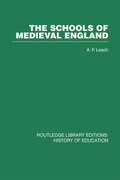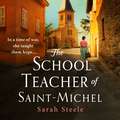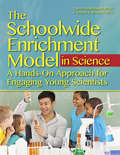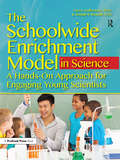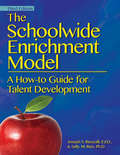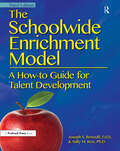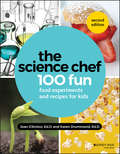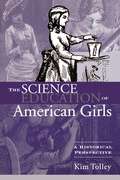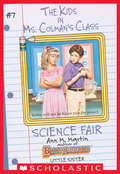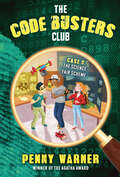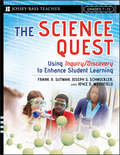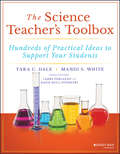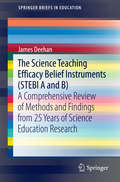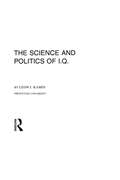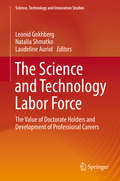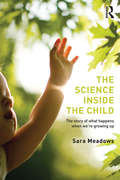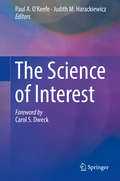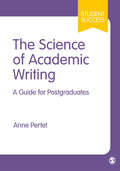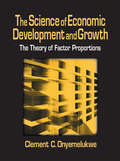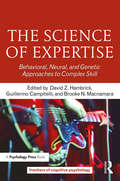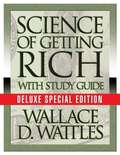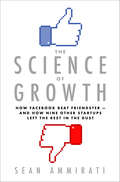- Table View
- List View
The Schools of Medieval England
by A F LeachOriginally published 1915. This reprints the edition of 1969. When originally published this volume was the first history of English schools before the Reformation, reckoned from the accession of Edward VI.
The Schoolteacher of Saint-Michel: inspired by real acts of resistance, a heartrending story of one woman's courage in WW2
by Sarah SteeleThe Schoolteacher of Saint Michel is a heartrending and deeply moving story of love and hope in World War II from the USA Today bestselling author of The Missing Pieces of Nancy Moon.The war taught her to fight. The children taught her to hope...Inspired by real acts of bravery and resistance, The Schoolteacher of Saint Michel is a heartrending and deeply moving story of one woman's courage and sacrifice during World War II, from the USA Today bestselling author of The Missing Piece of Nancy Moon. This exquisitely beautiful novel is perfect for readers of The Rose Code by Kate Quinn, The Postmistress, Lilac Girls and The Girl from Vichy.'A beautifully worked tale of bravery, woven into the reality of a time we can't forget' Mandy Robotham, author of The Berlin Girl'An emotional, beautifully constructed read. I loved the way the clues from the past and present slowly knitted together, answering the questions that had been missing their answers for so long' Sunday Times bestselling author Jill Mansell'Gripping, at times heartbreaking, but ultimately uplifting, I found this beautifully written novel impossible to put down' Sunday Times bestselling author Katie Fforde'My darling girl, I need you to find someone for me . . .'France, 1942. At the end of the day, the schoolteacher releases her pupils. She checks they have their identity passes, and warns them not to stop until the German guards have let them through the barrier that separates occupied France from Free France. As the little ones fly across the border and into their mothers' arms, she breathes a sigh of relief. No one is safe now. Not even the children.Berkshire, present day. A letter left to her by her beloved late grandmother Gigi takes Hannah Stone on a journey deep into the heart of the Dordogne landscape. As she begins to unravel a forgotten history of wartime bravery and sacrifice, she discovers the heartrending secret that binds her grandmother to a village schoolteacher, the remarkable Lucie Laval . . .'An engaging tale of courage and friendship. A triumph!' Gill Paul'Evocative writing and the storytelling is masterful. It really draws the reader in' Felicity Hayes-McCoy(P)2021 Headline Publishing Group Limited
The Schoolteacher of Saint-Michel: inspired by real acts of resistance, a heartrending story of one woman's courage in WW2
by Sarah SteeleThe war taught her to fight. The children taught her to hope...*The Lost Song of Paris, the new novel from Sarah Steele, is available to pre-order now!*Inspired by real acts of bravery and resistance, The Schoolteacher of Saint Michel is a heartrending and deeply moving story of one woman's courage and sacrifice during World War II, from the USA Today bestselling author of The Missing Piece of Nancy Moon. This exquisitely beautiful novel is perfect for readers of The Rose Code by Kate Quinn, The Postmistress, Lilac Girls and The Girl from Vichy.'A beautifully worked tale of bravery, woven into the reality of a time we can't forget' Mandy Robotham, author of The Berlin Girl'An emotional, beautifully constructed read. I loved the way the clues from the past and present slowly knitted together, answering the questions that had been missing their answers for so long' Sunday Times bestselling author Jill Mansell'Gripping, at times heartbreaking, but ultimately uplifting, I found this beautifully written novel impossible to put down' Sunday Times bestselling author Katie Fforde______'My darling girl, I need you to find someone for me . . .'France, 1942. At the end of the day, the schoolteacher releases her pupils. She checks they have their identity passes, and warns them not to stop until the German guards have let them through the barrier that separates occupied France from Free France. As the little ones fly across the border and into their mothers' arms, she breathes a sigh of relief. No one is safe now. Not even the children.Berkshire, present day. A letter left to her by her beloved late grandmother Gigi takes Hannah Stone on a journey deep into the heart of the Dordogne landscape. As she begins to unravel a forgotten history of wartime bravery and sacrifice, she discovers the heartrending secret that binds her grandmother to a village schoolteacher, the remarkable Lucie Laval . . .______'An engaging tale of courage and friendship. A triumph!' Gill Paul'Evocative writing and the storytelling is masterful. It really draws the reader in' Felicity Hayes-McCoy'A gripping journey about the quiet triumphs and breathtaking courage of so many women in wartime' Jane BaileyReaders ADORE The Schoolteacher of Saint Michel:'I loved this book, I finished reading it on VE Day. It is certainly a fitting tribute to the everyday people in France who resisted the German occupation in WW2. 5 stars''Absolutely fabulous. Highly recommend this. I've read The Missing Pieces of Nancy Moon - this is even better''Such a poignant story and beautiful characters. I can highly recommend this book''A lovely book, by turns emotional, exciting and heart-rending. The story is beautifully told. A book that will stay with me. Definitely recommended, particularly to anyone with an interest in World War II historical novels' 'A lovely story of courage and hope at a time of extreme adversity. Wonderfully written, descriptive and poignant. This one is special''Sheer escapism, beautifully written. I highly recommend it'
The Schoolwide Enrichment Model in Science
by Joseph Renzulli Nancy HeilbronnerGrounded in decades of research, the Schoolwide Enrichment Model (SEM) has been successfully implemented at hundreds of schools across the world. Now, The Schoolwide Enrichment Model in Science: A Hands-on Approach for Engaging Young Scientists takes high-engagement learning one step further by applying SEM teaching strategies to the science curriculum. In this book, teachers learn how to engage students and to teach the skills needed to complete meaningful, in-depth investigations in science. Activities are connected to the Next Generation Science Standards (NGSS) and current policy recommendations calling for the meaningful integration of technology and promoting thinking and doing like young scientists over rote memorization. Easy to read and use, the book incorporates many practical suggestions, as well as reproducible student and teacher handouts.
The Schoolwide Enrichment Model in Science: A Hands-On Approach for Engaging Young Scientists
by Nancy L. HeilbronnerGrounded in decades of research, the Schoolwide Enrichment Model (SEM) has been successfully implemented at hundreds of schools across the world. Now, The Schoolwide Enrichment Model in Science: A Hands-on Approach for Engaging Young Scientists takes high-engagement learning one step further by applying SEM teaching strategies to the science curriculum. In this book, teachers learn how to engage students and to teach the skills needed to complete meaningful, in-depth investigations in science. Activities are connected to the Next Generation Science Standards (NGSS) and current policy recommendations calling for the meaningful integration of technology and promoting thinking and doing like young scientists over rote memorization. Easy to read and use, the book incorporates many practical suggestions, as well as reproducible student and teacher handouts.
The Schoolwide Enrichment Model: A How-To Guide for Talent Development
by Sally Reis Joseph RenzulliThe Schoolwide Enrichment Model: A How-to Guide for Educational Excellence (3rd ed.) presents an inspirational model for helping students achieve in today's schools. Based on years of research, the Schoolwide Enrichment Model (SEM) is founded on highly successful practices developed for programs for gifted students and promotes "a rising tide lifts all ships" approach to school improvement. This guidebook shows educators step-by-step how to develop their own SEM program based on their own local resources, student population, and faculty. Instead of treating students as simply test numbers in a system, the model helps educators look at student strengths and interests and capitalize on them. The book highlights the model's fundamentals and underlying research and provides information about the model's school structures, organizational components, and service delivery. The book suggests methods for engaging and challenging identified gifted students and provides practical resources for teachers using the SEM.
The Schoolwide Enrichment Model: A How-To Guide for Talent Development
by Joseph S. Renzulli Sally M. ReisThe Schoolwide Enrichment Model: A How-to Guide for Talent Development (3rd ed.) presents a common sense approach for helping students achieve and engage in joyful learning. Based on years of research, the Schoolwide Enrichment Model (SEM) is founded on highly successful practices originally developed for programs for gifted students. The SEM promotes “a rising tide lifts all ships” approach to school improvement by applying general enrichment strategies to all students and opportunities for advanced level follow-up opportunities for superior learners and highly motivated students.This guidebook shows educators step by step how to develop their own SEM program based on their own local resources, student population, and faculty strengths and interests. Instead of offering students a one-size-fits-all curriculum, the model helps educators look at each student's strengths, interests, learning styles, and preferred modes of expression and capitalize on these assets. The book highlights the model's fundamentals and underlying research and provides information about organizational components, service delivery options, and resources for implementation. The book suggests methods for engaging and challenging identified gifted students and provides practical resources for teachers using the SEM with all students.
The Science Chef: 100 Fun Food Experiments and Recipes for Kids
by Joan D'Amico Karen E. DrummondServe Up the Magic of Science with Fun and Kid-Friendly Cooking Experiments Break out your best aprons and spatulas: The Science Chef: 100 Fun Food Experiments and Recipes for Kids, 2nd Edition teaches children the basics of science through a variety of fun experiments, activities, and recipes. Each chapter explores a different science topic by giving you an experiment or activity you can do right in your kitchen, followed by easy-to-make recipes using ingredients from the experiment. Altogether there are over 100 experiments, activities, and recipes for you to try. From learning why an onion makes you cry to how to bake the perfect cupcake, you'll bring the fundamentals of science to life in a new, magical way. The Science Chef covers a wide variety of scientific areas, like: How plants grow and produce seeds How the process of fermentation produces pickles The basics of nutrition How acids and bases react together to make baked items rise up in the oven While the first edition of this classic book has delighted readers for over twenty years, this new edition is sure to be an even bigger hit with the kids in your home. Bon Appetit!
The Science Education of American Girls: A Historical Perspective
by Kim TolleyThe Science Education of American Girls provides a comparative analysis of the science education of adolescent boys and girls, and analyzes the evolution of girls' scientific interests from the antebellum era through the twentieth century. Kim Tolley expands the understanding of the structural and cultural obstacles that emerged to transform what, in the early nineteenth century, was regarded as a "girl's subject." As the form and content of pre-college science education developed, Tolley argues, direct competition between the sexes increased. Subsequently, the cultural construction of science as a male subject limited access and opportunity for girls.
The Science Fair (The Kids in Ms. Colman's Class #7)
by Ann M. MartinFrom the bestselling author of the generation-defining series The Baby-sitters Club comes a series for a new generation!School is always fun in Ms. Colman's class!The kids in Ms. Colman's class are working on science projects. Bobby's group is studying a mouse named Harriet. Harriet is about to have babies. But then Harriet disappears. The science project is a big mess! And everyone thinks it is Bobby's fault.
The Science Fair Scheme (The Code Busters Club #8)
by Penny WarnerWill the Code Busters be able to unravel their latest case? Cody, Quinn, Luke, M.E., and Mika are the Code Busters—clever clue hunters with a passion for puzzles. They can’t wait to compete in the Science Fair. They each plan to come up with unique projects—all incorporating codes—for the chance to win first place! But when they discover someone spying on them and find pieces of their projects sabotaged, their chances of winning look slim. Will the Code Busters be able to find out who is spying on them? And can they salvage all their projects to win the prize? Can you crack the code? Test your brain with the Code Busters to see if you have the right stuff to be an ace detective. Answers are in the back, if you ever get stuck.
The Science Quest
by Joseph S. Sutman Frank X. Schmuckler Woodfield Joyce D.The Science Quest introduces the Inquiry/Discovery instructional framework, an innovative method for captivating students? interest in science, for building their skills in scientific thinking, and for dramatically enriching their understanding of scientific content and concepts. For teachers curious how to implement ?inquiry? learning as called for in the National Science Education Standards, this book provides detailed and practical guidance. It shows teachers how to transform ordinary lessons in ways that 1) encourage students to take initiative in posing scientific ?inquiry? questions; and 2) enable students to independently ?discover? answers to their questions by engaging in investigative practices and critically evaluating the findings. Inquiry/Discovery practices can be introduced in stages, starting with simple activities and gradually increasing the levels of challenge. The Science Quest includes everything a teacher needs to bring successful instruction, including: Extensive lesson planning and assessment tools Suggestions on working with students in teams Scores of sample lessons from varied disciplines
The Science Teacher's Activity-A-Day, Grades 5-10
by Pam Walker Elaine WoodA hands-on and fun-filled resource for teaching science to middle and high school students New in the 5-Minute Fundamentals Series, The Science Teacher's Activity-A-Day, Grades 6-12, includes 180 easy, five-minute hook or sponge activities to capture learners' attention and introduce lessons. Divided into three units, Physical Science, Life Science, and Earth and Space Science; the activities cover topics based on the National Science Education Standards. All the book's activities can be done with materials that are inexpensive and easy to findIncludes quick and fun "sponge" activities that are designed to engage studentsAll the activities take about 5 minutes to complete The Science Teacher's Activity-a-Day is an ideal resource for middle and high school science teachers.
The Science Teacher's Toolbox: Hundreds of Practical Ideas to Support Your Students (The Teacher's Toolbox Series)
by Tara C. Dale Mandi S. WhiteA winning educational formula of engaging lessons and powerful strategies for science teachers in numerous classroom settings The Teacher’s Toolbox series is an innovative, research-based resource providing teachers with instructional strategies for students of all levels and abilities. Each book in the collection focuses on a specific content area. Clear, concise guidance enables teachers to quickly integrate low-prep, high-value lessons and strategies in their middle school and high school classrooms. Every strategy follows a practical, how-to format established by the series editors. The Science Teacher's Toolbox is a classroom-tested resource offering hundreds of accessible, student-friendly lessons and strategies that can be implemented in a variety of educational settings. Concise chapters fully explain the research basis, necessary technology, Next Generation Science Standards correlation, and implementation of each lesson and strategy. Favoring a hands-on approach, this bookprovides step-by-step instructions that help teachers to apply their new skills and knowledge in their classrooms immediately. Lessons cover topics such as setting up labs, conducting experiments, using graphs, analyzing data, writing lab reports, incorporating technology, assessing student learning, teaching all-ability students, and much more. This book enables science teachers to: Understand how each strategy works in the classroom and avoid common mistakes Promote culturally responsive classrooms Activate and enhance prior knowledge Bring fresh and engaging activities into the classroom and the science lab Written by respected authors and educators, The Science Teacher's Toolbox: Hundreds of Practical Ideas to Support Your Students is an invaluable aid for upper elementary, middle school, and high school science educators as well those in teacher education programs and staff development professionals.
The Science Teaching Efficacy Belief Instruments (STEBI A and B)
by James DeehanThe purpose of this Springer Brief is to provide a comprehensive review of both the STEBI methods and findings through the use of a clearly defined analytic framework. A systematic review of literature yielded 107 STEBI-A research items and 140 STEBI-B research items. The STEBI instruments have been used in a wide range of qualitative, cross sectional, longitudinal and experimental designs. Analysis of the findings of the papers reveals that in-service and pre-service programs that use innovative practices such as cooperative learning, inquiry based investigation and nature of science instruction can produce positive growth in participants' science teaching efficacy beliefs. The personal science teaching efficacy beliefs of pre-service and in-service teachers showed greater mean scores and higher growth than their outcome expectancies. Implications are discussed.
The Science and Politics of I.q. (Penguin Education Ser.)
by L. J. KaminPublished in 1974, The Science and Politics of I.q. is a valuable contribution to the field of Education.
The Science and Technology Labor Force
by Leonid Gokhberg Natalia Shmatko Laudeline AuriolThis book provides an in-depth analysis of the demand for PhDs on the labor markets of twelve countries. The authors analyze the role of PhDs in the creation of innovation in a knowledge-based economy and examine economic issues such as the return on investment for the education and training of doctoral graduates. To provide a more comprehensive picture of the employment patterns, career paths and mobility of PhDs in selected countries, the book analyzes various data sources such as labor force surveys and censuses. The authors also develop survey approaches and output tables to collect data on the transition from school to work among PhDs. The book will be of interest to policymakers, companies and researchers responsible for research and innovation systems, as well as to doctoral students looking for a professional career outside the academic world.
The Science inside the Child: The story of what happens when we're growing up
by Sara MeadowsThis engaging book presents some of the ways in which science can describe and explain how and why children develop in the way they do. It looks at children’s individual development within the development of our species, at genes, at the hormone systems that flood our bodies, at the neuroscience of children’s brains, and at patterns of behaviour. It looks, in other words, at the different influences on child development according to the scientific disciplines of evolutionary theory, genetics, epigenetics, endocrinology, neuroscience, epidemiology and psychology. Filled with entertaining anecdotes, Sara Meadows shares the story of what happens when we’re growing up, revealing how science can add depth to our understanding. This book will be an informative and enriching read for all parents, educators and carers, and those interested in how children develop to be emotionally balanced, socially skilled, and enthusiastic seekers after knowledge.
The Science of Interest
by Paul A. O'Keefe Judith M. HarackiewiczThis exceptional volume analyzes the intricate roles interest plays in cognition, motivation and learning, and daily living, with a special focus on its development and maintenance across life domains. Leading experts discuss a spectrum of interest ranging from curiosity to obsession, and trace its functions in goal-setting, decision-making, self-regulation, and performance. New research refines the current knowledge on student interest in educational settings and the social contexts of interest, with insights into why interest levels change during engagement and in the long run. From these findings, contributors address ways to foster and nurture interest in the therapy room and the classroom, for optimum benefits throughout life. Among the topics covered: #65533; Embedding interest within self-regulation. #65533; Knowledge acquisition at the intersection of situational and individual interest. #65533; The role of interest in motivation and engagement. #65533; The two faces of passion. #65533; Creative geniuses, polymaths, child prodigies, and autistic savants. #65533; The promotion and development of interest. A robust guide to a fascinating area of study, The Science of Interest synthesizes the field's current knowledge of interest and indicates future directions. Its chapters contribute depth and rigor to this growing area of research, and will enhance the work of researchers in education, psychologists, social scientists, and public policymakers.
The Science of Academic Writing: A Guide for Postgraduates (Student Success)
by Anne PertetAre you unsure what your thesis should look like? Perhaps you are struggling to get started or tie everything together in your conclusion? Help is here! Taking you from the introduction all the way through to the conclusion, this practical guide will provide you with step-by-step guidance, examples, checklists and expert tips to help you write your thesis with confidence. Student Success is a series of essential guides for students of all levels. From how to think critically and write great essays to boosting your employability and managing your wellbeing, the Student Success series helps you study smarter and get the best from your time at university. .
The Science of Academic Writing: A Guide for Postgraduates (Student Success)
by Anne PertetAre you unsure what your thesis should look like? Perhaps you are struggling to get started or tie everything together in your conclusion? Help is here! Taking you from the introduction all the way through to the conclusion, this practical guide will provide you with step-by-step guidance, examples, checklists and expert tips to help you write your thesis with confidence. Student Success is a series of essential guides for students of all levels. From how to think critically and write great essays to boosting your employability and managing your wellbeing, the Student Success series helps you study smarter and get the best from your time at university. .
The Science of Economic Development and Growth: The Theory of Factor Proportions
by C.C. OnyemelukweA theoretical framework aiming to facilitate study of development economics. The author presents his theory in three sections: how advanced nations developed; a proposed third dimension, in addition to labour and capital; and why capital accumulation is unnecessary, even potentially harmful.
The Science of Expertise: Behavioral, Neural, and Genetic Approaches to Complex Skill (Frontiers of Cognitive Psychology)
by David Z. Hambrick Guillermo Campitelli Brooke N. MacnamaraOffering the broadest review of psychological perspectives on human expertise to date, this volume covers behavioral, computational, neural, and genetic approaches to understanding complex skill. The chapters show how performance in music, the arts, sports, games, medicine, and other domains reflects basic traits such as personality and intelligence, as well as knowledge and skills acquired through training. In doing so, this book moves the field of expertise beyond the duality of "nature vs. nurture" toward an integrative understanding of complex skill. This book is an invaluable resource for researchers and students interested in expertise, and for professionals seeking current reviews of psychological research on expertise.
The Science of Getting Rich: With Study Guide
by Wallace D WattlesThis revolutionary primer on prosperity consciousness has been enriching millions since it was first published in 1910. It was, in fact, the inspiration for The Secret.The way to prosperity is no longer a mystery. You too can prosper from the "exact science" of achieving financial success as you learn to: Change your life by changing your thoughtsAttract the prosperity you deserveAppreciate the opportunities that await youLive true to the values most precious to youManage stress and self-defeating impulses that hold you backMake the contribution to the world that only you can make, and enjoy the abundance you'll receive in returnThis deluxe edition of the classic work, The Science of Getting Rich, includes a 21st century study guide structured with introspective questions that will allow you to explore your inner world, and applythe wisdom the author imparts to your life. It will be a remarkable journey of rejuvenation and self-discovery.
The Science of Growth: How Facebook Beat Friendster—and How Nine Other Startups Left the Rest in the Dust
by Sean AmmiratiIn The Science of Growth, venture capitalist and Carnegie Mellon professor Sean Ammirati tackles the dos and don'ts of successful scaling, by looking at the startups that have won—and lost.The lean entrepreneurship movement has captivated Silicon Valley and entrepreneurs across the country. It's provided an agile framework to develop the right product solution for a given target market, and is now used by almost every fledgling company to do just that.The next challenge is growth - to achieve the financial returns and, more importantly, the impact they dreamed of when starting off on their adventure. Why do some companies realize the VC's goal of a 10x return on investment, while others flounder? What differentiates the companies that become part of the fabric of our lives and remain responsive, no matter how big they get from those that quickly fade? To find out, Ammirati looks at 20 different companies in pairs, who have achieved product-market fit at about the same point in history with the same general target customer-one of which has gone on to achieve real scale, while the other languished.As his research reveals, just a handful of choices-among them, who to partner with, how to finance growth, and how to use data-make all the difference in the world. With such intriguing examples as LinkedIn vs. Spoke, Facebook vs. Friendster, and McDonald's vs. White Castle, Ammirati shows the secret of "the science of growth" and how to cultivate it in any organization.
